Dye Dale, O`neill Robert. The road to victory: From Pearl Harbor to Okinawa
Подождите немного. Документ загружается.

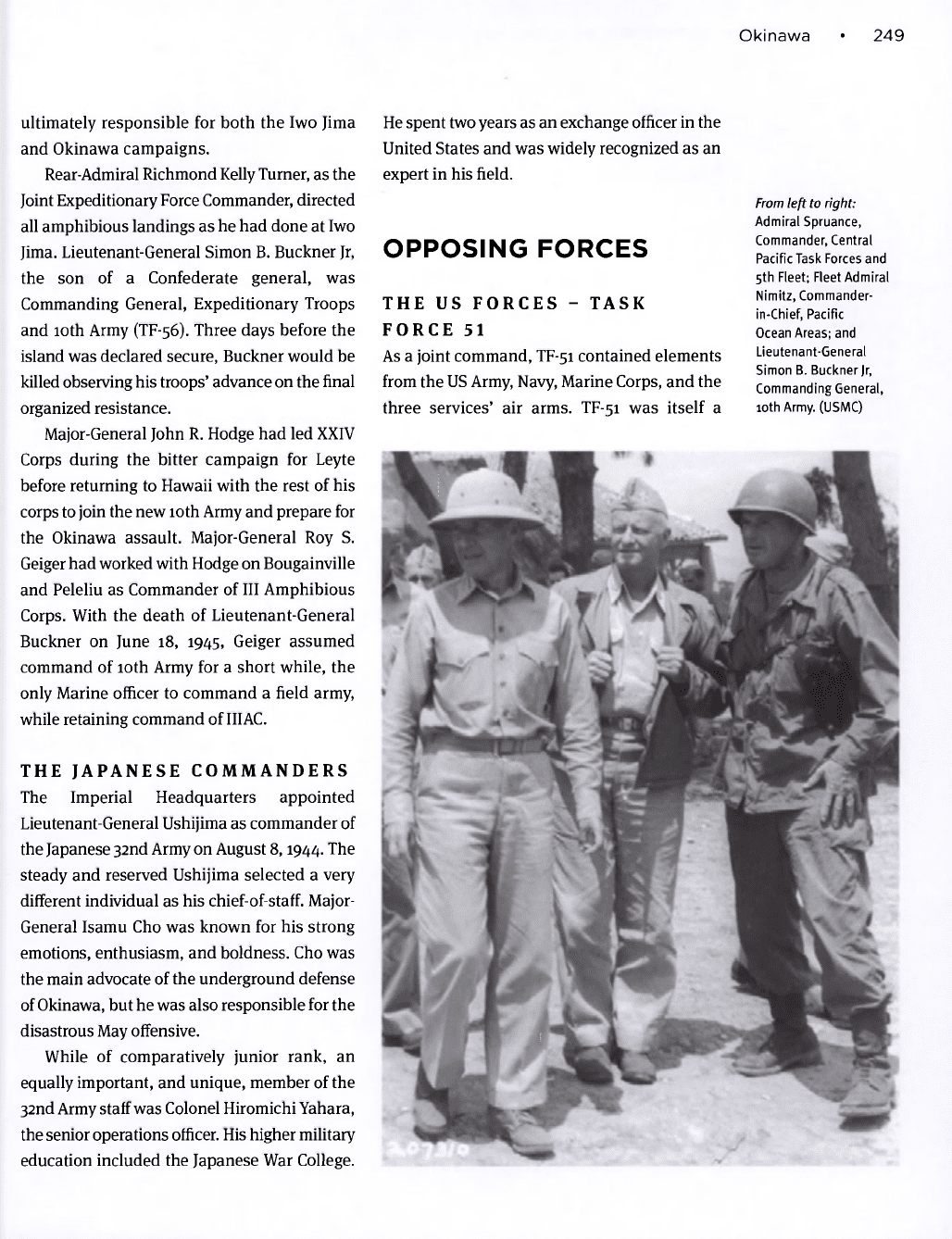
Okinawa • 249
ultimately responsible for both the Iwo Jima
and Okinawa campaigns.
Rear-Admiral Richmond Kelly Turner, as the
Joint Expeditionary Force Commander, directed
all amphibious landings as he had done at Iwo
Jima. Lieutenant-General Simon B. Buckner Jr,
the son of a Confederate general, was
Commanding General, Expeditionary Troops
and 10th Army (TF-56). Three days before the
island was declared secure, Buckner would be
killed observing his troops' advance on the final
organized resistance.
Major-General John R. Hodge had led XXIV
Corps during the bitter campaign for Leyte
before returning to Hawaii with the rest of his
corps to join the new 10th Army and prepare for
the Okinawa assault. Major-General Roy S.
Geiger had worked with Hodge on Bougainville
and Peleliu as Commander of III Amphibious
Corps. With the death of Lieutenant-General
Buckner on June 18, 1945, Geiger assumed
command of 10th Army for a short while, the
only Marine officer to command a field army,
while retaining command of IIIAC.
THE JAPANESE COMMANDERS
The Imperial Headquarters appointed
Lieutenant-General Ushijima as commander of
the Japanese 32nd Army on August 8,1944. The
steady and reserved Ushijima selected a very
different individual as his chief-of-stalf. Major-
General Isamu Cho was known for his strong
emotions, enthusiasm, and boldness. Cho was
the main advocate of the underground defense
of Okinawa, but he was also responsible for the
disastrous May offensive.
While of comparatively junior rank, an
equally important, and unique, member of the
32nd Army staff was Colonel Hiromichi Yahara,
the senior operations
officer.
His higher military
education included the Japanese War College.
He spent two years as an exchange
officer
in the
United States and was widely recognized as an
expert in his field.
OPPOSING FORCES
THE US FORCES - TASK
FORCE 51
As a joint command, TF-51 contained elements
from the US Army, Navy, Marine Corps, and the
three services' air arms. TF-51 was itself a
From left to right:
Admiral Spruance,
Commander, Central
Pacific Task Forces and
5th Fleet; Fleet Admiral
Nimitz, Commander-
in-Chief, Pacific
Ocean Areas; and
Lieutenant-General
Simon B. Buckner Jr,
Commanding General,
10th Army. (USMC)
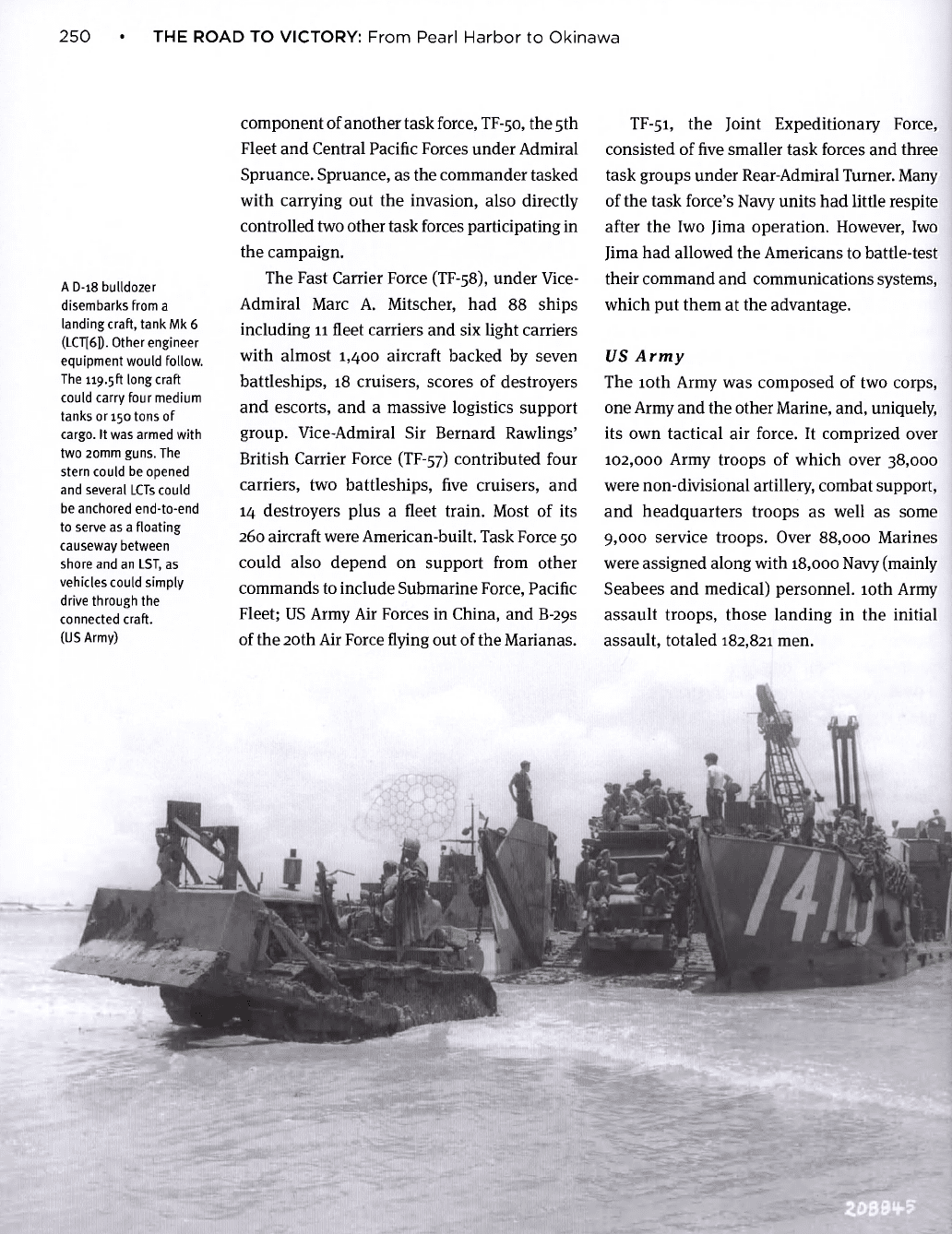
250 • THE ROAD TO VICTORY: From Pearl Harbor to Okinawa
A D-18 bulldozer
disembarks from a
landing craft, tank Mk 6
(LCT[6D. Other engineer
equipment would follow.
The 119.5ft long craft
could carry four medium
tanks or 150 tons of
cargo. It was armed with
two 20mm guns. The
stern could be opened
and several LCTs could
be anchored end-to-end
to serve as a floating
causeway between
shore and an LST, as
vehicles could simply
drive through the
connected craft.
(US Army)
component of another task force, TF-50, the 5th
Fleet and Central Pacific Forces under Admiral
Spruance. Spruance, as the commander tasked
with carrying out the invasion, also directly
controlled two other task forces participating in
the campaign.
The Fast Carrier Force (TF-58), under Vice-
Admiral Marc A. Mitscher, had 88 ships
including 11 fleet carriers and six light carriers
with almost 1,400 aircraft backed by seven
battleships, 18 cruisers, scores of destroyers
and escorts, and a massive logistics support
group. Vice-Admiral Sir Bernard Rawlings'
British Carrier Force (TF-57) contributed four
carriers, two battleships, five cruisers, and
14 destroyers plus a fleet train. Most of its
260 aircraft were American-built. Task Force 50
could also depend on support from other
commands to include Submarine Force, Pacific
Fleet; US Army Air Forces in China, and B-29S
of the 20th Air Force flying out of the Marianas.
TF-51, the Joint Expeditionary Force,
consisted of five smaller task forces and three
task groups under Rear-Admiral Turner. Many
of the task force's Navy units had little respite
after the Iwo Jima operation. However, Iwo
Jima had allowed the Americans to battle-test
their command and communications systems,
which put them at the advantage.
US Army
The 10th Army was composed of two corps,
one Army and the other Marine, and, uniquely,
its own tactical air force. It comprized over
102,000 Army troops of which over 38,000
were non-divisional artillery, combat support,
and headquarters troops as well as some
9,000 service troops. Over 88,000 Marines
were assigned along with 18,000 Navy (mainly
Seabees and medical) personnel. 10th Army
assault troops, those landing in the initial
assault, totaled 182,821 men.
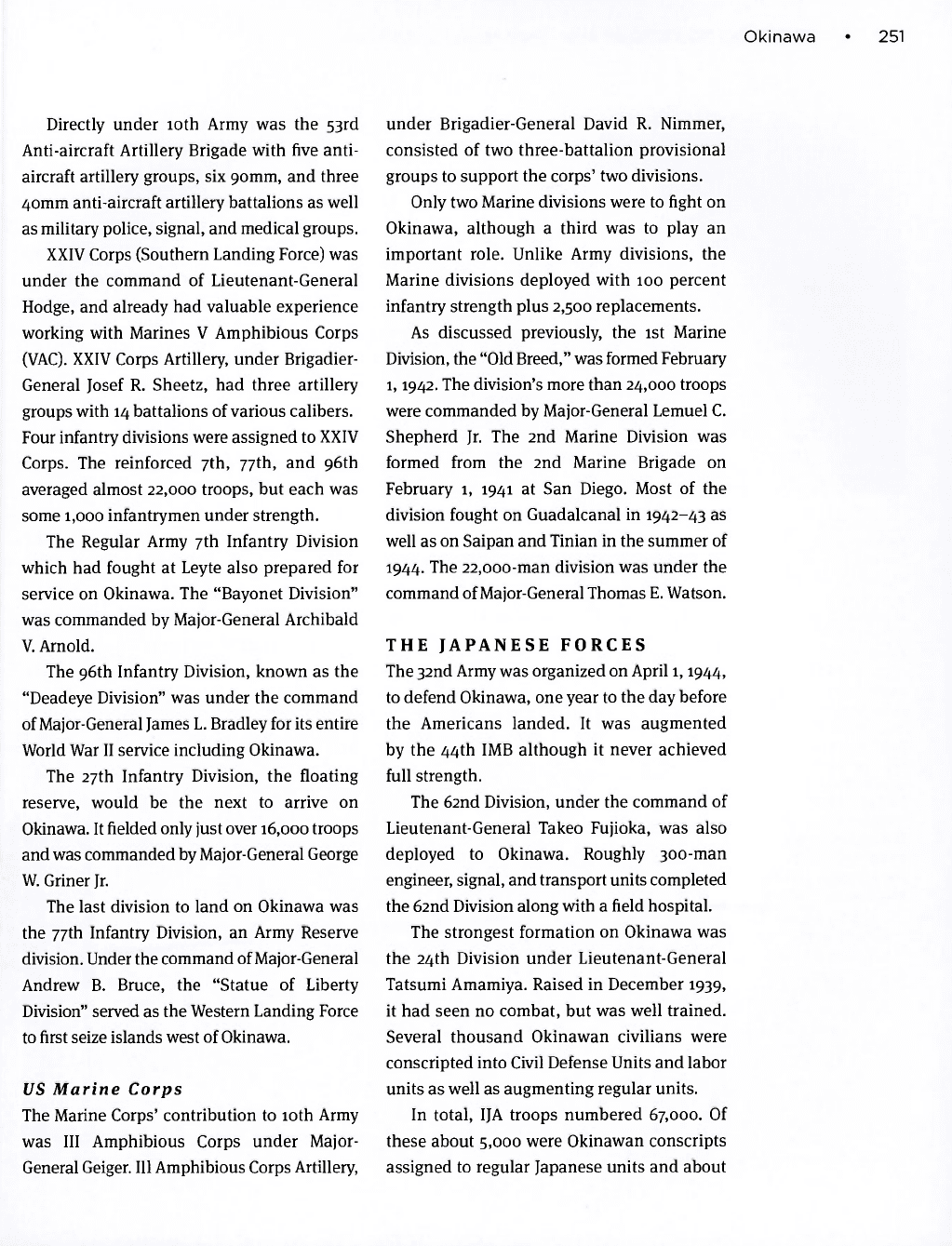
Okinawa • 251
Directly under 10th Army was the 53rd
Anti-aircraft Artillery Brigade with five anti-
aircraft artillery groups, six 90mm, and three
40mm anti-aircraft artillery battalions as well
as military police, signal, and medical groups.
XXIV Corps (Southern Landing Force) was
under the command of Lieutenant-General
Hodge, and already had valuable experience
working with Marines V Amphibious Corps
(VAC). XXIV Corps Artillery, under Brigadier-
General Josef R. Sheetz, had three artillery
groups with 14 battalions of various calibers.
Four infantry divisions were assigned to XXIV
Corps. The reinforced 7th, 77th, and 96th
averaged almost 22,000 troops, but each was
some 1,000 infantrymen under strength.
The Regular Army 7th Infantry Division
which had fought at Leyte also prepared for
service on Okinawa. The "Bayonet Division"
was commanded by Major-General Archibald
V. Arnold.
The 96th Infantry Division, known as the
"Deadeye Division" was under the command
of Major-General James L. Bradley for its entire
World War II service including Okinawa.
The 27th Infantry Division, the floating
reserve, would be the next to arrive on
Okinawa. It fielded only just over 16,000 troops
and was commanded by Major-General George
W. Griner Jr.
The last division to land on Okinawa was
the 77th Infantry Division, an Army Reserve
division. Under the command of Major-General
Andrew B. Bruce, the "Statue of Liberty
Division" served as the Western Landing Force
to first seize islands west of Okinawa.
US Marine Corps
The Marine Corps' contribution to 10th Army
was III Amphibious Corps under Major-
General Geiger. Ill Amphibious Corps Artillery,
under Brigadier-General David R. Nimmer,
consisted of two three-battalion provisional
groups to support the corps' two divisions.
Only two Marine divisions were to fight on
Okinawa, although a third was to play an
important role. Unlike Army divisions, the
Marine divisions deployed with 100 percent
infantry strength plus 2,500 replacements.
As discussed previously, the 1st Marine
Division, the "Old Breed," was formed February
1,1942. The division's more than 24,000 troops
were commanded by Major-General Lemuel C.
Shepherd Jr. The 2nd Marine Division was
formed from the 2nd Marine Brigade on
February 1, 1941 at San Diego. Most of the
division fought on Guadalcanal in 1942-43 as
well as on Saipan and Tinian in the summer of
1944. The 22,000-man division was under the
command of Major-General Thomas E. Watson.
THE JAPANESE FORCES
The 32nd Army was organized on April 1,1944,
to defend Okinawa, one year to the day before
the Americans landed. It was augmented
by the 44th 1MB although it never achieved
full strength.
The 62nd Division, under the command of
Lieutenant-General Takeo Fujioka, was also
deployed to Okinawa. Roughly 300-man
engineer, signal, and transport units completed
the 62nd Division along with a field hospital.
The strongest formation on Okinawa was
the 24th Division under Lieutenant-General
Tatsumi Amamiya. Raised in December 1939,
it had seen no combat, but was well trained.
Several thousand Okinawan civilians were
conscripted into Civil Defense Units and labor
units as well as augmenting regular units.
In total, IJA troops numbered 67,000. Of
these about 5,000 were Okinawan conscripts
assigned to regular Japanese units and about
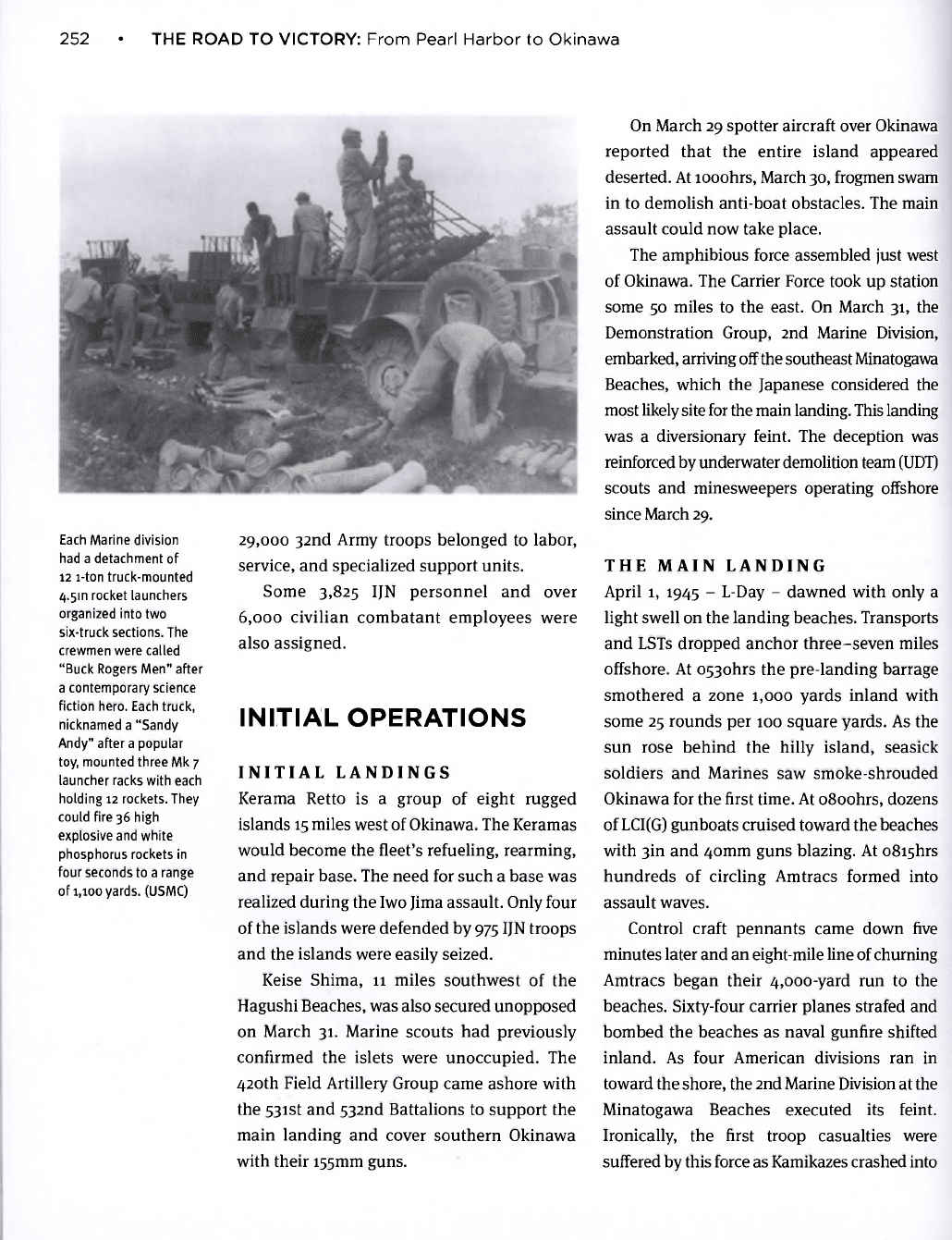
252 • THE ROAD TO VICTORY: From Pearl Harbor to Okinawa
Each Marine division
had a detachment of
12 l-ton truck-mounted
4.5m rocket launchers
organized into two
six-truck sections. The
crewmen were called
"Buck Rogers Men" after
a contemporary science
fiction hero. Each truck,
nicknamed a "Sandy
Andy" after a popular
toy, mounted three Mk 7
launcher racks with each
holding 12 rockets. They
could fire 36 high
explosive and white
phosphorus rockets in
four seconds to a range
of 1,100 yards. (USMC)
29,000 32nd Army troops belonged to labor,
service, and specialized support units.
Some 3,825 IJN personnel and over
6,000 civilian combatant employees were
also assigned.
INITIAL OPERATIONS
INITIAL LANDINGS
Kerama Retto is a group of eight rugged
islands 15 miles west of Okinawa. The Keramas
would become the fleet's refueling, rearming,
and repair base. The need for such a base was
realized during the Iwo Jima assault. Only four
of the islands were defended by 975 IJN troops
and the islands were easily seized.
Keise Shima, 11 miles southwest of the
Hagushi Beaches, was also secured unopposed
on March 31. Marine scouts had previously
confirmed the islets were unoccupied. The
420th Field Artillery Group came ashore with
the 531st and 532nd Battalions to support the
main landing and cover southern Okinawa
with their 155mm guns.
On March 29 spotter aircraft over Okinawa
reported that the entire island appeared
deserted. At looohrs, March 30, frogmen swam
in to demolish anti-boat obstacles. The main
assault could now take place.
The amphibious force assembled just west
of Okinawa. The Carrier Force took up station
some 50 miles to the east. On March 31, the
Demonstration Group, 2nd Marine Division,
embarked, arriving off the southeast Minatogawa
Beaches, which the Japanese considered the
most likely site for the main landing. This landing
was a diversionary feint. The deception was
reinforced by underwater demolition team (UDT)
scouts and minesweepers operating offshore
since March 29.
THE MAIN LANDING
April 1, 1945 - L-Day - dawned with only a
light swell on the landing beaches. Transports
and LSTs dropped anchor three-seven miles
offshore. At 0530hrs the pre-landing barrage
smothered a zone 1,000 yards inland with
some 25 rounds per 100 square yards. As the
sun rose behind the hilly island, seasick
soldiers and Marines saw smoke-shrouded
Okinawa for the first time. At o8oohrs, dozens
of
LCI(G)
gunboats cruised toward the beaches
with 3in and 40mm guns blazing. At o8ishrs
hundreds of circling Amtracs formed into
assault waves.
Control craft pennants came down five
minutes later and an eight-mile line of churning
Amtracs began their 4,000-yard run to the
beaches. Sixty-four carrier planes strafed and
bombed the beaches as naval gunfire shifted
inland. As four American divisions ran in
toward the shore, the 2nd Marine Division at the
Minatogawa Beaches executed its feint.
Ironically, the first troop casualties were
suffered by this force as Kamikazes crashed into
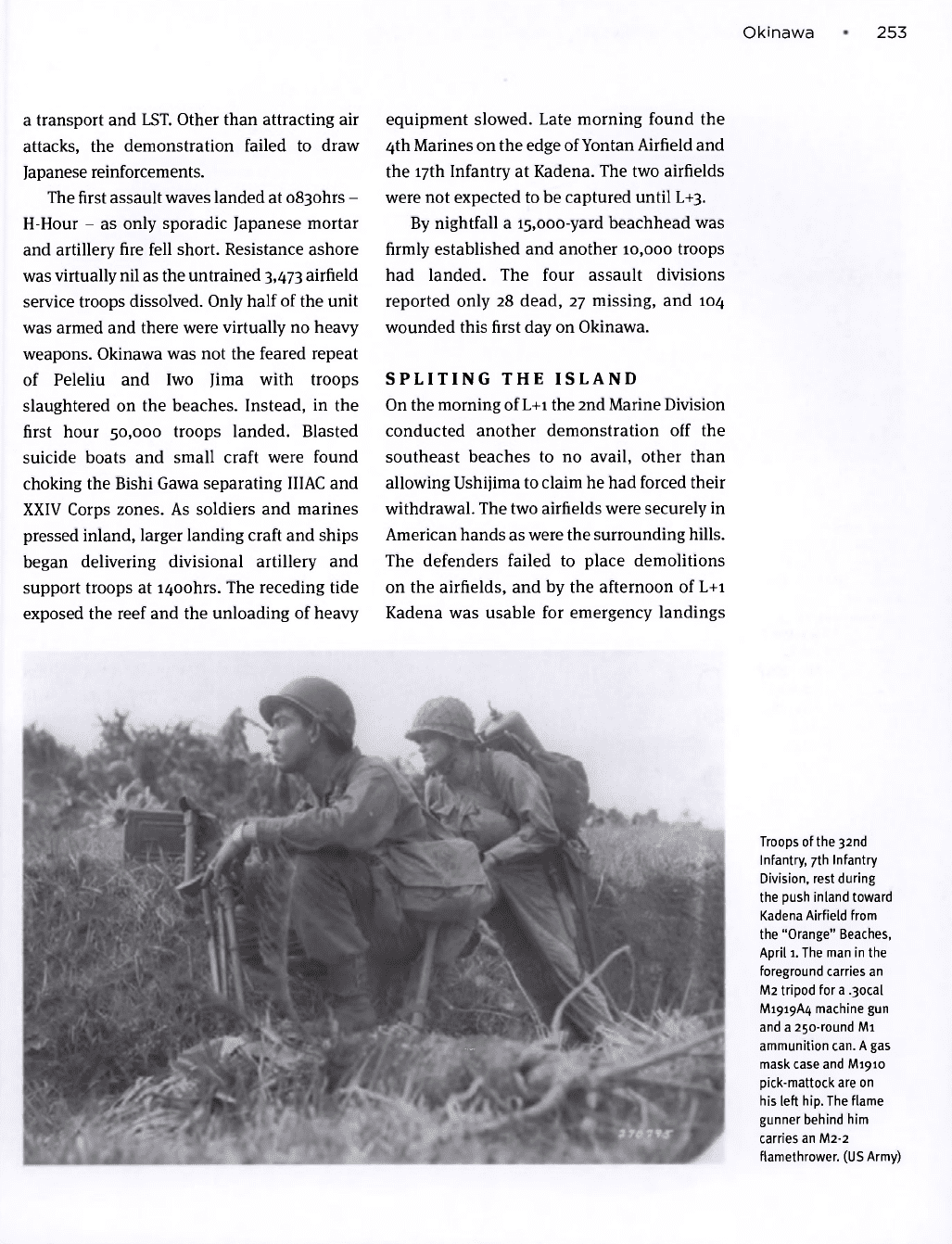
Okinawa • 253
a transport and LST. Other than attracting air
attacks, the demonstration failed to draw
Japanese reinforcements.
The first assault waves landed at o83ohrs -
H-Hour - as only sporadic Japanese mortar
and artillery fire fell short. Resistance ashore
was virtually nil as the untrained 3,473 airfield
service troops dissolved. Only half of the unit
was armed and there were virtually no heavy
weapons. Okinawa was not the feared repeat
of Peleliu and Iwo Jima with troops
slaughtered on the beaches. Instead, in the
first hour 50,000 troops landed. Blasted
suicide boats and small craft were found
choking the Bishi Gawa separating IIIAC and
XXIV Corps zones. As soldiers and marines
pressed inland, larger landing craft and ships
began delivering divisional artillery and
support troops at i400hrs. The receding tide
exposed the reef and the unloading of heavy
Troops of the 32nd
Infantry, 7th Infantry
Division, rest during
the push inland toward
Kadena Airfield from
the "Orange" Beaches,
April 1. The man in the
foreground carries an
M2 tripod for a .30cal
M1919A4 machine gun
and a 250-round Mi
ammunition can. A gas
mask case and M1910
pick-mattock are on
his left hip. The flame
gunner behind him
carries an M2-2
flamethrower. (US Army)
equipment slowed. Late morning found the
4th Marines on the edge of Yon tan Airfield and
the 17th Infantry at Kadena. The two airfields
were not expected to be captured until L+3.
By nightfall a 15,000-yard beachhead was
firmly established and another 10,000 troops
had landed. The four assault divisions
reported only 28 dead, 27 missing, and 104
wounded this first day on Okinawa.
SPLITING THE ISLAND
On the morning of L+i the 2nd Marine Division
conducted another demonstration off the
southeast beaches to no avail, other than
allowing Ushijima to claim he had forced their
withdrawal. The two airfields were securely in
American hands as were the surrounding hills.
The defenders failed to place demolitions
on the airfields, and by the afternoon of L+i
Kadena was usable for emergency landings
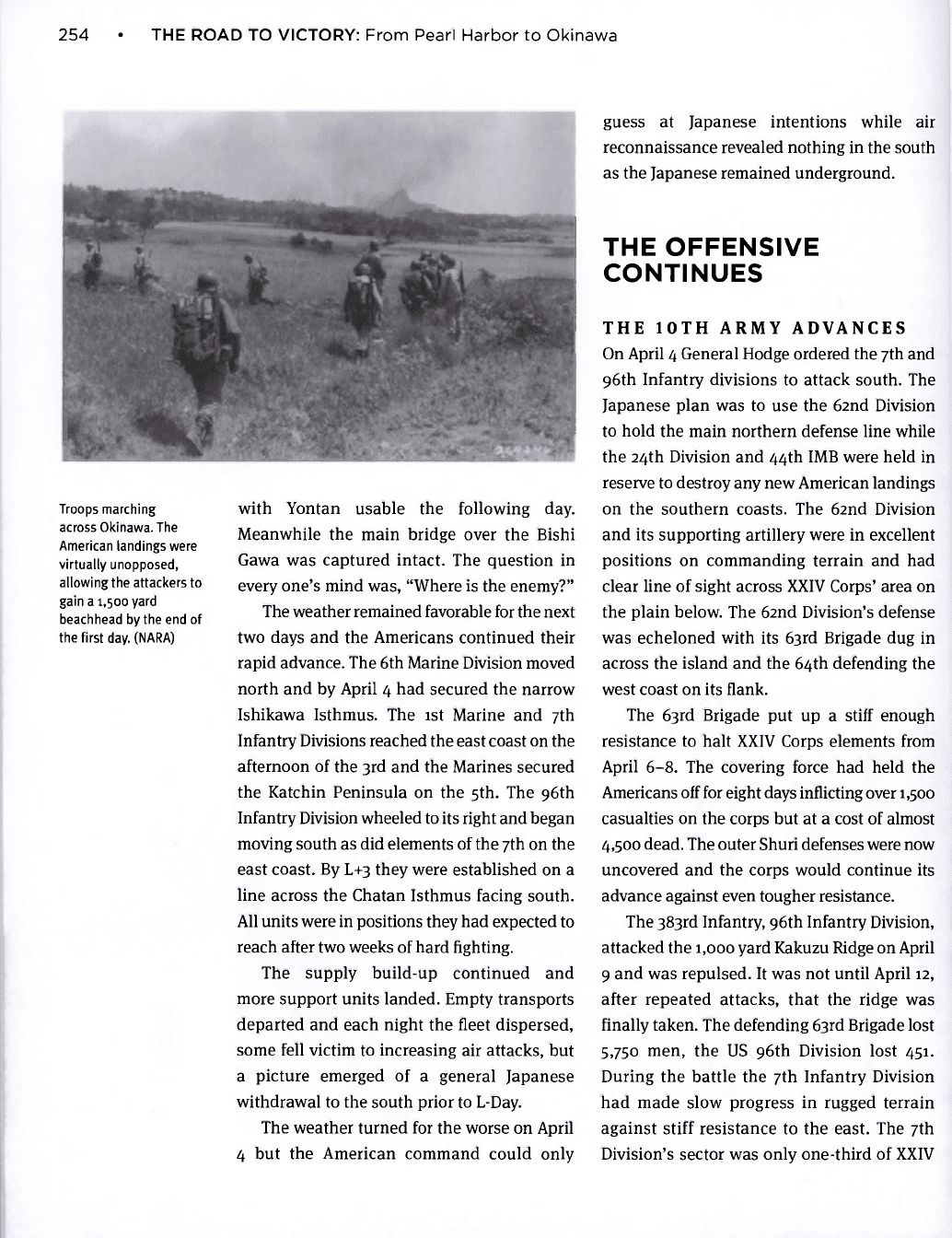
254 • THE ROAD TO VICTORY: From Pearl Harbor to Okinawa
Troops marching
across Okinawa. The
American landings were
virtually unopposed,
allowing the attackers to
gain a 1,500 yard
beachhead by the end of
the first day. (NARA)
with Yontan usable the following day.
Meanwhile the main bridge over the Bishi
Gawa was captured intact. The question in
every one's mind was, "Where is the enemy?"
The weather remained favorable for the next
two days and the Americans continued their
rapid advance. The 6th Marine Division moved
north and by April 4 had secured the narrow
Ishikawa Isthmus. The 1st Marine and 7th
Infantry Divisions reached the east coast on the
afternoon of the 3rd and the Marines secured
the Katchin Peninsula on the 5th. The 96th
Infantry Division wheeled to its right and began
moving south as did elements of the 7th on the
east coast. By L+3 they were established on a
line across the Chatan Isthmus facing south.
All units were in positions they had expected to
reach after two weeks of hard fighting.
The supply build-up continued and
more support units landed. Empty transports
departed and each night the fleet dispersed,
some fell victim to increasing air attacks, but
a picture emerged of a general Japanese
withdrawal to the south prior to L-Day.
The weather turned for the worse on April
4 but the American command could only
guess at Japanese intentions while air
reconnaissance revealed nothing in the south
as the Japanese remained underground.
THE OFFENSIVE
CONTINUES
THE 10TH ARMY ADVANCES
On April 4 General Hodge ordered the 7th and
96th Infantry divisions to attack south. The
Japanese plan was to use the 62nd Division
to hold the main northern defense line while
the 24th Division and 44th 1MB were held in
reserve to destroy any new American landings
on the southern coasts. The 62nd Division
and its supporting artillery were in excellent
positions on commanding terrain and had
clear line of sight across XXIV Corps' area on
the plain below. The 62nd Division's defense
was echeloned with its 63rd Brigade dug in
across the island and the 64th defending the
west coast on its flank.
The 63rd Brigade put up a stiff enough
resistance to halt XXIV Corps elements from
April 6-8. The covering force had held the
Americans off
for
eight days inflicting over 1,500
casualties on the corps but at a cost of almost
4,500 dead. The outer Shuri defenses were now
uncovered and the corps would continue its
advance against even tougher resistance.
The 383rd Infantry, 96th Infantry Division,
attacked the 1,000 yard Kakuzu Ridge on April
9 and was repulsed. It was not until April 12,
after repeated attacks, that the ridge was
finally taken. The defending 63rd Brigade lost
5,750 men, the US 96th Division lost 451.
During the battle the 7th Infantry Division
had made slow progress in rugged terrain
against stiff resistance to the east. The 7th
Division's sector was only one-third of XXIV
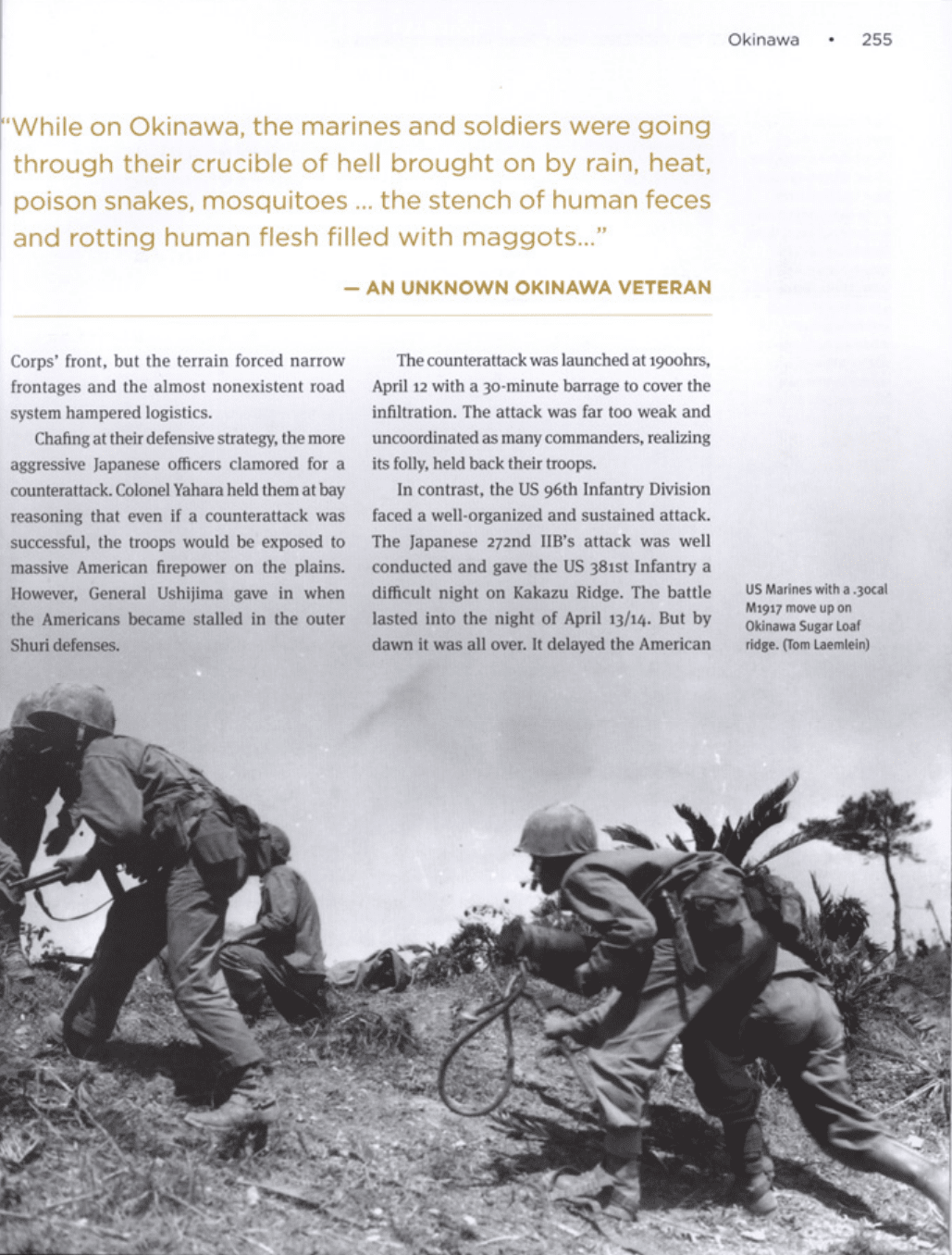
Okinawa • 255
'While on Okinawa, the marines and soldiers were going
through their crucible of hell brought on by rain, heat,
poison snakes, mosquitoes ... the stench of human feces
and rotting human flesh filled with maggots..."
- AN UNKNOWN OKINAWA VETERAN
US Marines with a .3ocal
M1917 move up on
Okinawa Sugar Loaf
ridge. (Tom Laemlein)
The counterattack was launched at igoohrs,
April 12 with a 30-minute barrage to cover the
infiltration. The attack was far too weak and
uncoordinated as many commanders, realizing
its folly, held back their troops.
In contrast, the US 96th Infantry Division
faced a well-organized and sustained attack.
The Japanese 272nd IIB's attack was well
conducted and gave the US 381st Infantry a
difficult night on Kakazu Ridge. The battle
lasted into the night of April 13/14. But by
dawn it was all over. It delayed the American
Corps' front, but the terrain forced narrow
frontages and the almost nonexistent road
system hampered logistics.
Chafing at their defensive strategy, the more
aggressive Japanese officers clamored for a
counterattack. Colonel Yahara held them at bay
reasoning that even if a counterattack was
successful, the troops would be exposed to
massive American firepower on the plains.
However, General Ushijima gave in when
the Americans became stalled in the outer
Shuri defenses.
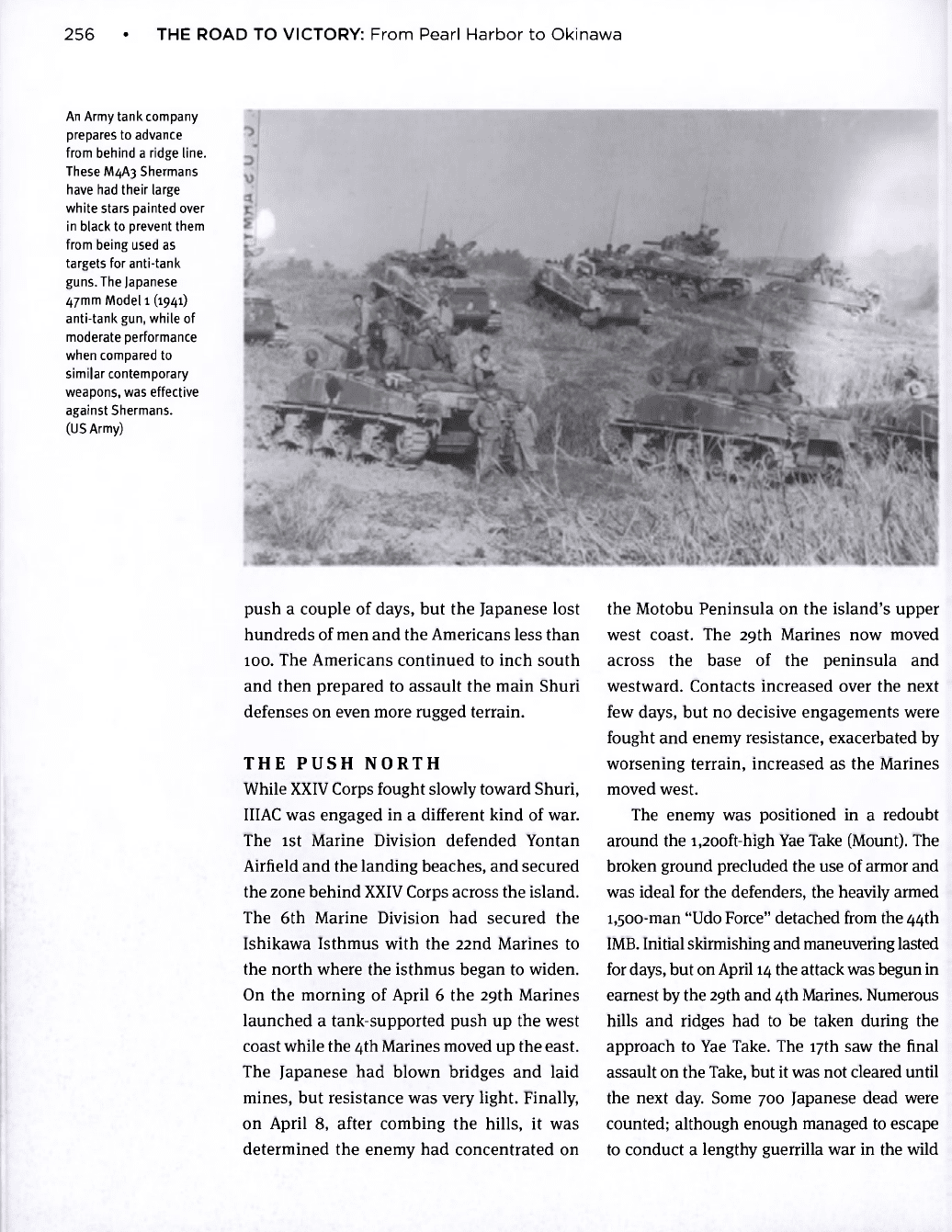
256 • THE ROAD TO VICTORY: From Pearl Harbor to Okinawa
An Army tank company
prepares to advance
from behind a ridge line.
These M4A3 Shermans
have had their large
white stars painted over
in black to prevent them
from being used as
targets for anti-tank
guns. The Japanese
47mm Model 1 (1941)
anti-tank gun, while of
moderate performance
when compared to
similar contemporary
weapons, was effective
against Shermans.
(US Army)
push a couple of days, but the Japanese lost
hundreds of men and the Americans less than
100. The Americans continued to inch south
and then prepared to assault the main Shuri
defenses on even more rugged terrain.
THE PUSH NORTH
While XXIV Corps fought slowly toward Shuri,
IIIAC was engaged in a different kind of war.
The 1st Marine Division defended Yontan
Airfield and the landing beaches, and secured
the zone behind XXIV Corps across the island.
The 6th Marine Division had secured the
Ishikawa Isthmus with the 22nd Marines to
the north where the isthmus began to widen.
On the morning of April 6 the 29th Marines
launched a tank-supported push up the west
coast while the 4th Marines moved up the east.
The Japanese had blown bridges and laid
mines, but resistance was very light. Finally,
on April 8, after combing the hills, it was
determined the enemy had concentrated on
the Motobu Peninsula on the island's upper
west coast. The 29th Marines now moved
across the base of the peninsula and
westward. Contacts increased over the next
few days, but no decisive engagements were
fought and enemy resistance, exacerbated by
worsening terrain, increased as the Marines
moved west.
The enemy was positioned in a redoubt
around the i,200ft-high Yae Take (Mount). The
broken ground precluded the use of armor and
was ideal for the defenders, the heavily armed
1,500-man "Udo Force" detached from the 44th
1MB. Initial skirmishing and maneuvering lasted
for days, but on April 14 the attack was begun in
earnest by the 29th and 4th Marines. Numerous
hills and ridges had to be taken during the
approach to Yae Take. The 17th saw the final
assault on the Take, but it was not cleared until
the next day. Some 700 Japanese dead were
counted; although enough managed to escape
to conduct a lengthy guerrilla war in the wild
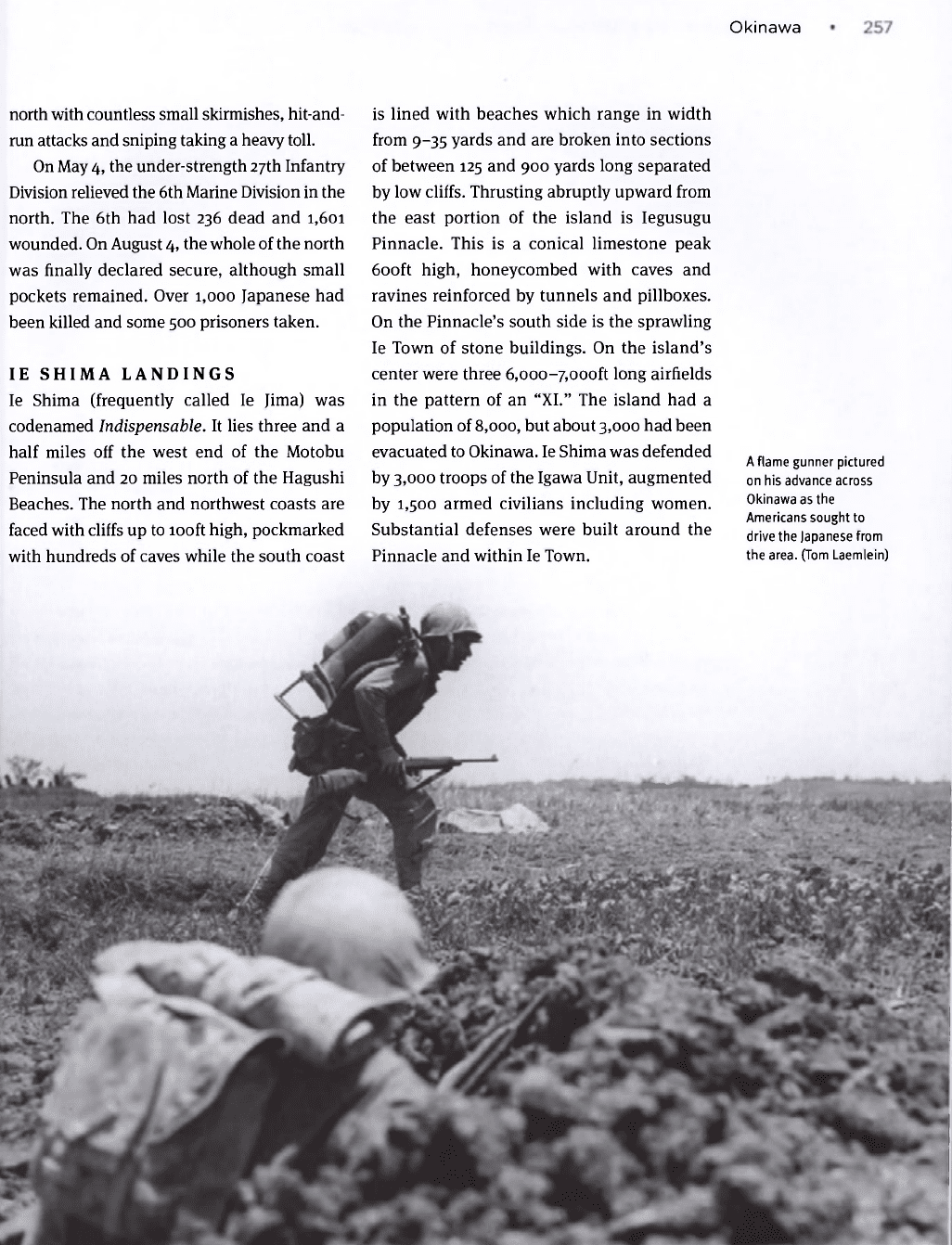
north with countless small skirmishes, hit-and-
run attacks and sniping taking a heavy toll.
On May 4, the under-strength 27th Infantry
Division relieved the 6th Marine Division in the
north. The 6th had lost 236 dead and 1,601
wounded. On August 4, the whole of the north
was finally declared secure, although small
pockets remained. Over 1,000 Japanese had
been killed and some 500 prisoners taken.
IE SHIMA LANDINGS
Ie Shima (frequently called Ie Jima) was
codenamed Indispensable. It lies three and a
half miles off the west end of the Motobu
Peninsula and 20 miles north of the Hagushi
Beaches. The north and northwest coasts are
faced with cliffs up to 100ft high, pockmarked
with hundreds of caves while the south coast
Okinawa
is lined with beaches which range in width
from 9-35 yards and are broken into sections
of between 125 and 900 yards long separated
by low cliffs. Thrusting abruptly upward from
the east portion of the island is Iegusugu
Pinnacle. This is a conical limestone peak
600ft high, honeycombed with caves and
ravines reinforced by tunnels and pillboxes.
On the Pinnacle's south side is the sprawling
Ie Town of stone buildings. On the island's
center were three 6,ooo-7,oooft long airfields
in the pattern of an "XI." The island had a
population of 8,000, but about 3,000 had been
evacuated to Okinawa. Ie Shima was defended
by 3,000 troops of the Igawa Unit, augmented
by 1,500 armed civilians including women.
Substantial defenses were built around the
Pinnacle and within Ie Town.
A flame gunner pictured
on his advance across
Okinawa as the
Americans sought to
drive the Japanese from
the area. (Tom Laemlein)
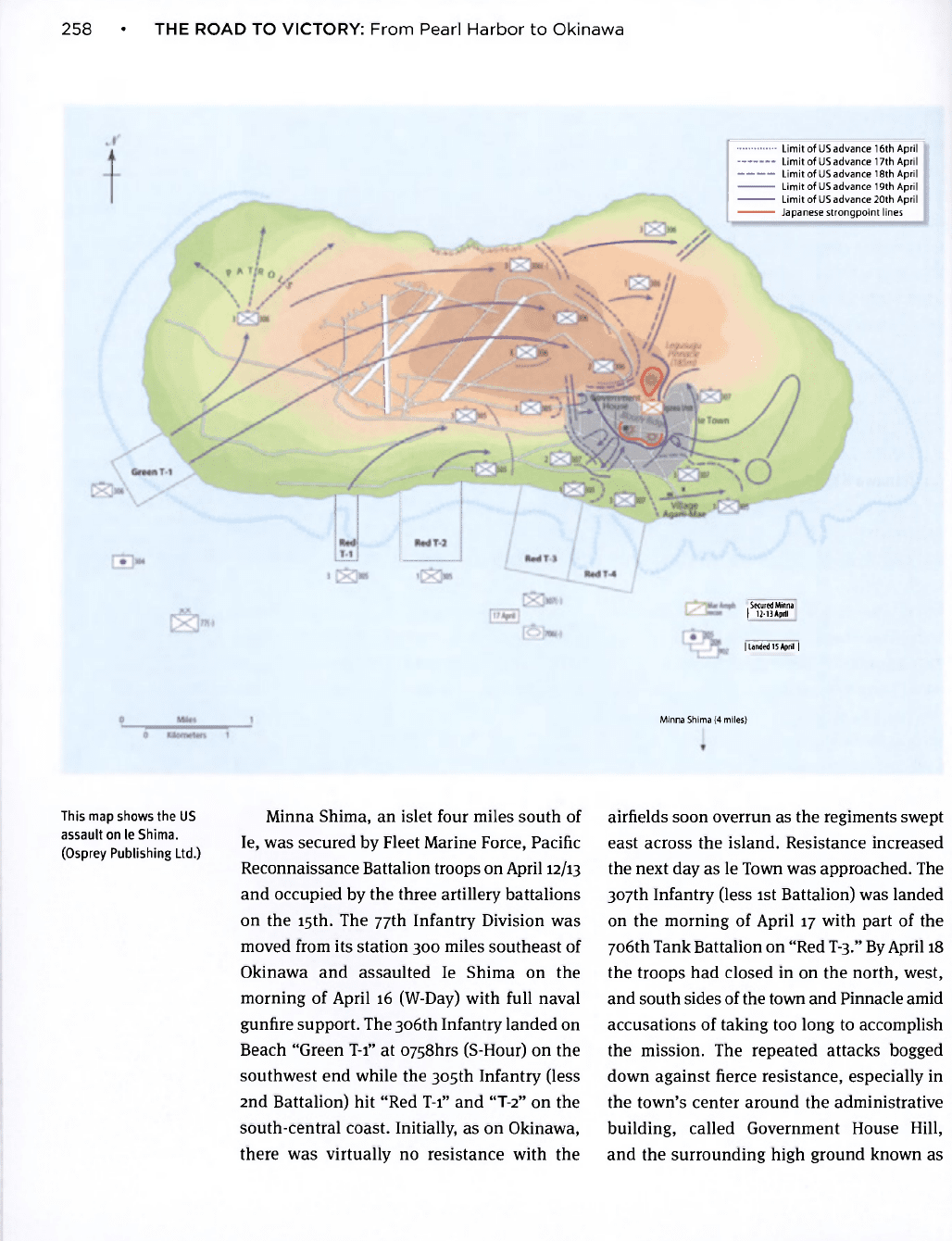
258 • THE ROAD TO VICTORY: From Pearl Harbor to Okinawa
Limit of US advance 16th April
Limit of US advance 17th April
Limit of US advance 18th April
Limit of US advance 19th April
———— Limit of US advance 20th April
Japanese strongpoint lines
SMured Minna
|
12
13 April
| Landed 15 Aprii~|
Minna Shima (4 miles)
This map shows the US
assault on le Shima.
(Osprey Publishing Ltd.)
Minna Shima, an islet four miles south of
le, was secured by Fleet Marine Force, Pacific
Reconnaissance Battalion troops on April 12/13
and occupied by the three artillery battalions
on the 15th. The 77th Infantry Division was
moved from its station 300 miles southeast of
Okinawa and assaulted le Shima on the
morning of April 16 (W-Day) with full naval
gunfire support. The 306th Infantry landed on
Beach "Green T-i" at 0758hrs (S-Hour) on the
southwest end while the 305th Infantry (less
2nd Battalion) hit "Red T-i" and "T-2" on the
south-central coast. Initially, as on Okinawa,
there was virtually no resistance with the
airfields soon overrun as the regiments swept
east across the island. Resistance increased
the next day as le Town was approached. The
307th Infantry (less 1st Battalion) was landed
on the morning of April 17 with part of the
706th Tank Battalion on "Red T-3." By April 18
the troops had closed in on the north, west,
and south sides of the town and Pinnacle amid
accusations of taking too long to accomplish
the mission. The repeated attacks bogged
down against fierce resistance, especially in
the town's center around the administrative
building, called Government House Hill,
and the surrounding high ground known as
